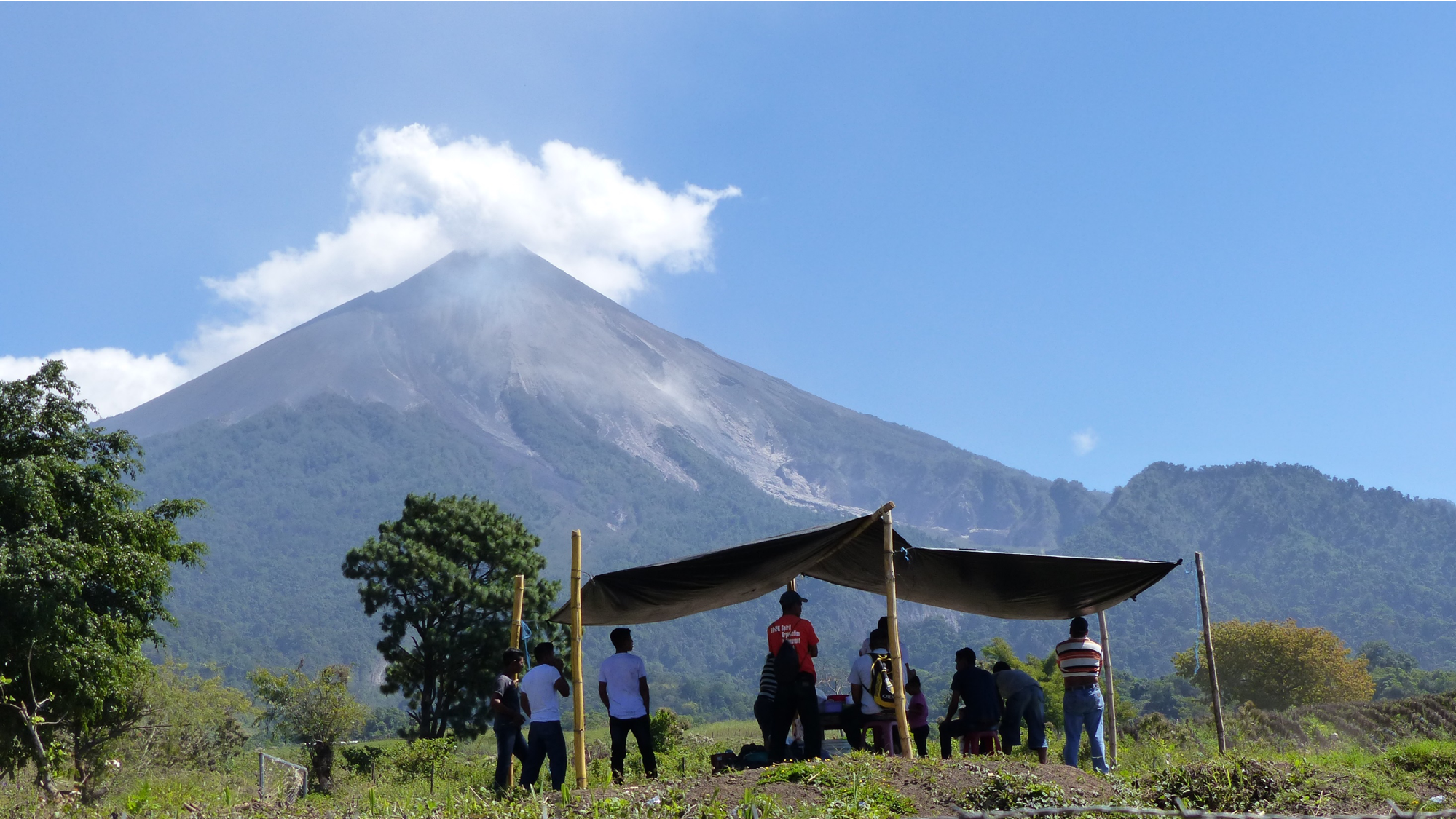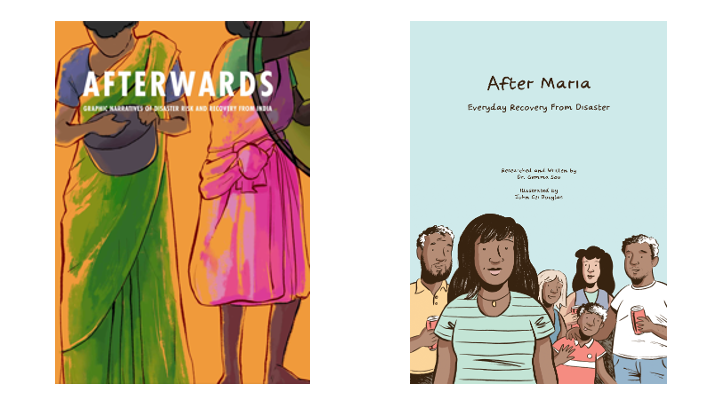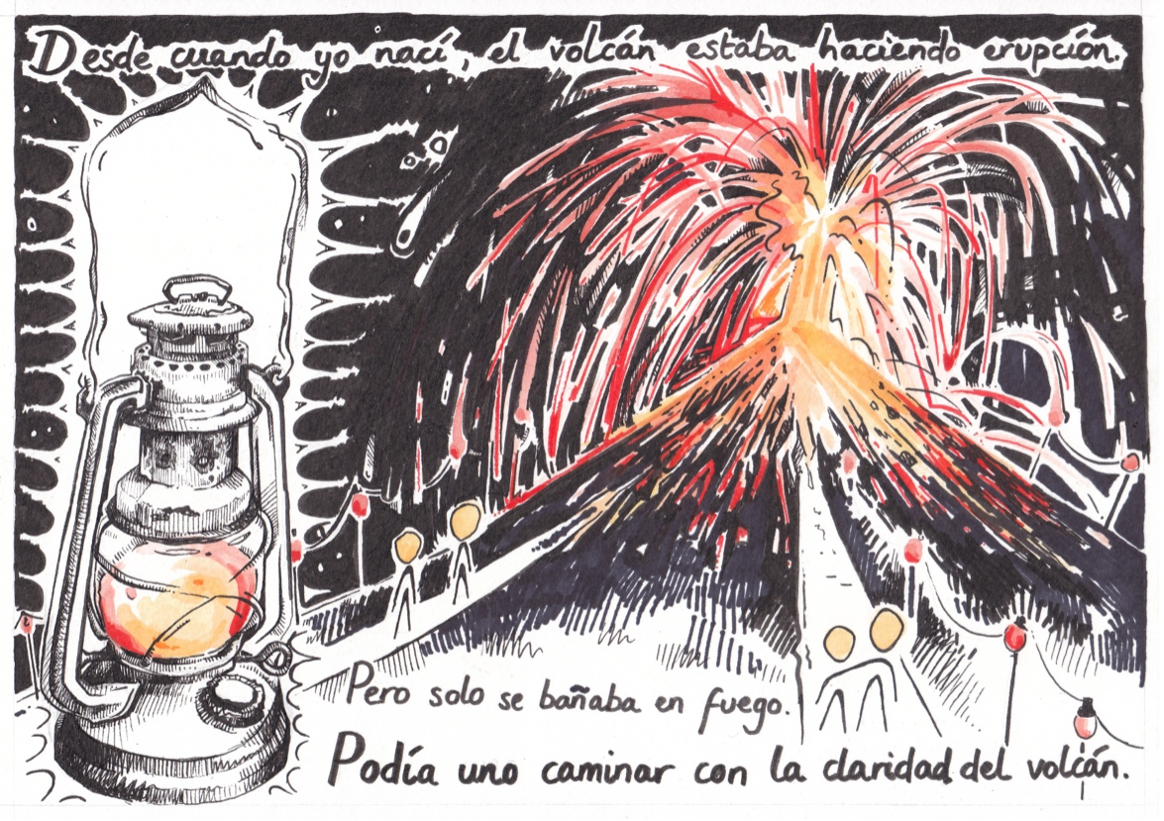Illustrating Fuego: Tangled and Tangible (Self-)expression
Published in Earth & Environment and Arts & Humanities


Starting motivations
For many years, I worked on the active Fuego volcano in Guatemala. I spent time with people living on Fuego’s slopes and heard their stories about its eruptions. While my initial research focused on Fuego’s recent explosive activity, I became interested in also understanding how that activity is experienced by local people. Older people on Fuego’s west slopes often told me about eruptions in the 1960s and 1970s that had devastating impacts on their communities. These people spoke of loss, and change – how those events shaped their livelihood outcomes and choices – while lamenting the lack of channels to share their knowledge of these eruptions within and beyond their communities.
Researchers increasingly recognise that individual voices are absent or homogenised in many accounts of disaster, and are exploring creative approaches to broadcast these missing voices. Just as case study can inform generalised understanding, individual stories of disaster can represent the diversity of ways that people live with environmental change; representation that is particularly pertinent as disasters associated with climate change increase and intensify. At active volcanoes, stories of past eruptions tell us about both the physical processes of the natural event and the sensations of those people who witnessed it. We need both physical and social perspectives to fully understand volcanoes and our relation to them.
I have been moved by beautiful examples of researchers using creative practices to codevelop narratives of disaster and recovery with local people – including comics , graphic narratives, and music-enhanced interviews. These inspired me to invite people at Fuego to co-create a book telling their stories of its past eruptions through their words and my art. The motivations of this study were (1) to sensitively explore experiences of volcanic disaster through art; (2) to translate experiences to a tangible format that could be shared within and beyond affected communities.

Theory into practice
This study was supported by the Ixchel project and an arts council seed grant. Seed funding is so valuable for exploratory research where methods are developed in practice. I planned three main activities:
- A series of individual consultations on illustrations drawn from interviews;
- Two participatory workshops;
- A second series of group consultations.
Even with the flexibility these grants afforded, I met challenges in translating theory into practice. For instance, local people's interest in the project fluctuated. Some people who were initially most keen were later ambivalent. Conversely, other people who seemed uninterested at first asked later if I could create a book with their community – tempting, but no small undertaking!
I also confronted the question of how to assess how illustrations were received. When I shared illustrations in consultations, some people expressed gratitude at seeing their experiences visualized; some, apparent indifference. Evaluation was something I built in as the project progressed.
Finally, I learned that ‘co-development’ is a Tardis of questions about power and control in the research process. Did illustrations of people’s stories of disaster allow them to shape the research? When one older lady said my drawing captured her memory exactly, perhaps she meant she wouldn’t change anything, but perhaps too that she couldn’t. I found the participatory workshops that I organised fun and tough simultaneously– people had lots of opportunity to shape and share their stories creatively, and I had to relinquish my vision of what a story about Fuego would look like! In this project, I was both researcher and artist. This diverges from research that inspired me, where those roles are separate. I recognised that holding both roles afforded me a lot of control, while allowing me two means to connect with people at Fuego. The tangled challenges and promise of this dual responsibility could only be learned through doing.
Outputs and lessons learned
Some lessons I learned in this study recreate known challenges in disaster research (see this excellent guide). Was this recreation unnecessary? Not at all! I think there’s value in learning through practice challenges you recognise in theory. Plunging into participatory arts-based research impressed on me how complex and valuable this work is, and I emerged with an even stronger motivation to work with people around active volcanoes in ways that amplify their experiences and voices. The lessons of this study had to be learned through practice. And, while there was discomfort in this learning (for example, the disconnection implied in interactions like “this story is not ours” - see article), these uncomfortable conversations often led to more comfortable relationships.
I also learned through practice the value of combining more- and less-participatory methods. Some responses of local people to my illustrations (e.g., the interaction closing the article's Discussion) show the value of representing individual stories of disaster through less participatory methods. I appreciate the insights of a colleague who, during a crucial point in writing the article, pointed me to a different research field (art history) that argued for the power of illustration to capture vanishing experiences in a tangible format.
This study allowed exploration of the different ways that zines and illustration can empower people by representing their untold stories of disaster. Because it required learning by doing, the study also taught me a great deal about the challenges and promise of my methods and approach. This project was possible because of my deep relationship with the people of Fuego; similar relationships powered the research that inspired me. I see value for researchers using these methods in future – to honour and enrich existing relationships with the people with whom they work, and to acknowledge the individual humanity of these people and themselves.

Memories of Fuego's past activity, told through a local person's words and illustrated by the author.
Follow the Topic
-
Journal of Applied Volcanology

This is an international journal with a focus on applied research relating to volcanism and particularly its societal impacts. Characterising volcanic impacts and associated risk relies on not only quantifying physical threat but also understanding social and physical vulnerability and resilience.
Related Collections
With Collections, you can get published faster and increase your visibility.
Community voices and volcanic risk reduction: co-production, participatory research, and community-led approaches to risk
This Collection will highlight research and case studies that adopt participatory, community-led, or co-produced approaches to volcanic risk and resilience.
Experience and research into effective volcanic risk reduction highlights the importance of community involvement and community-led approaches to understanding and anticipating risk, as well as effective response, and recovery. Systems and solutions that do not include community needs, can reduce their efficacy, and, at worst disengage those communities, wasting resources and creating risk. Identifying approaches to volcanic risk reduction in partnership with communities can foster community ownership, empowerment, and control; enhancing the resilience of those communities. Co-production of risk knowledge and risk solutions not only result in outcomes that are more meaningful, relevant, and successful, but can also lead to improved understanding of volcanic risk for all parties.
However, developing participation with communities presents multiple challenges: including lack of community resources, time to engage alongside other priorities, language and communication barriers, the need to spark engagement or interest, lack of awareness of community challenges and systemic barriers, etc. Recently, novel approaches to working with communities have been identified to overcome such participation challenges, including citizen science projects, engagement of appropriate facilitators and community leaders, knowledge co-production and resource sharing initiatives. There is also a growing awareness about the importance of ethical and just partnerships: built with an awareness of the prior history of the region, the communities, their cultural practices, and relationships with authorities. By incorporating multiple perspectives of risk and knowledge, particularly those of indigenous peoples, there is greater potential to increase relevance, efficacy, and cultural appropriateness of co-produced systems and solutions. Leveraging different types of knowledge also offers opportunities to set up risk governance approaches that are inclusive, and help to redress power imbalances between stakeholders.
In this Collection we seek to highlight community participation initiatives in volcanic contexts and capture this emerging knowledge. We are interested in articles that address the spectrum of approaches and challenges. This encompasses the spectrum of community engagement from wholly community-led initiatives, through knowledge co-production, to novel examples of successful engagement led by volcano scientists or managers of risk. We particularly welcome reflections on pitfalls and challenges, and even examples of failure. We will also consider many definitions of community: from local communities and populations, through to communities of stakeholders and decision-makers. We thus seek contributions from the broad communities involved in understanding and managing volcanic risk: including physical and social scientists, indigenous researchers, practitioners, policy and planners, emergency managers, central and local government, and local community leaders.
We encourage authors to share experiences and methods for empowering local communities, authorities and partnerships, engaging multiple and diverse stakeholders, understanding local expressions of hazards and risk, and sharing responsibilities, as beacons for the core goals of the SENDAI Framework. Volcanic risk settings are inherently multi-hazard, and can present outstanding exemplars of means to “leave no-one behind” in the context of sustainable development and global environmental change. This speaks directly to the aspirations of both the SENDAI framework and the UN Sustainable Development goals which seeks to eliminate poverty (Goal 1) and share knowledge and education (Goal 4) with all (Goals 5 and 10), for the development of inclusive and sustainable settlements (Goal 11). As such, we also welcome contributions that consider implications of this work for sustainable development in other contexts.
Topics of interest include:
• Research exploring effective approaches to participatory, community-led, and co-produced volcanic risk assessment and management.
• Reviews and application of different tools and methodologies for ensuring community voices in volcanology: e.g., participatory action research, design science, collaborative planning process.
• Descriptions of research design and methodologies to monitor and evaluate the success of such approaches.
• Novel methods and tools that have been used to effectively engage communities.
• Case studies outlining approaches used, challenges, and lessons, including relationship building and management and how the spectrum of participation is determined.
• Indigenous perspectives to risk and risk management in volcanic contexts.
•Ethics of participations: for engagement, for research, for partnerships.
•Reviews of the challenges and barriers (e.g., resources, time, capacity, language differences) and proposed solutions, or examples, to overcome them.
•Tools and approaches to identify community needs.
•Case studies for volcanic risk assessment, forecasts and warnings, evacuation planning, risk reduction or management, resilience building, response, and recovery.
• Other contributions outlining research or case studies of approaches or best practices for fostering participation in the understanding of, and management of, volcanic risk.
Prior abstract submissions are not necessary, however the Guest Editors welcome authors to discuss ideas they may have for manuscripts prior to submission. Springer Nature offers several options for open access fee support, these include institutional open access agreements, reduced fees for waivers for corresponding authors based in lower income countries (as defined by the World bank), and case-by-case waivers or discounts based on financial need. The Journal of Applied Volcanology also has a limited number of Journal-specific partial and full fee waivers that can be assessed on a case-by-case basis based on need. If you are interested in applying, please indicate your interest at the point of manuscript submission and outline your case in your submission letter. More information can be found here.
This Collection supports and amplifies research related to SDG 1, No Poverty, SDG 4, Quality Education, SDG 10, Reduced Inequalities, and SDG 11, Sustainable Cities & Communities.
All submissions in this collection undergo the journal’s standard peer review process. Similarly, all manuscripts authored by a Guest Editor(s) will be handled by the Editor-in-Chief. As an open access publication, this journal levies an article processing fee (details here). We recognize that many key stakeholders may not have access to such resources and are committed to supporting participation in this issue wherever resources are a barrier. For more information about what support may be available, please visit OA funding and support, or email OAfundingpolicy@springernature.com or the Editor-in-Chief.
Publishing Model: Open Access
Deadline: Dec 31, 2025
Data Visualization and Effective Communication in Volcanology: Cross-disciplinary Lessons from Research and Practice
Journal of Applied Volcanology is calling for submissions to our Collection on Data Visualization and Effective Communication in Volcanology: Cross-disciplinary Lessons from Research and Practice.
This collection will highlight effective approaches for visualising and communicating volcanic information: from monitoring data to hazard model outputs, through to risk, impact, vulnerability information, and more.
Effective communication of technical information is critical to enhance the understanding of a volcano’s history, status, or forecast, and is vital for effective risk management. However, it is important not just to consider the aesthetic qualities of visual displays, we must consider how our visualisation and communication choices impact people’s responses to information, including how it may affect their decision performance. The effective display of critical information also impacts trust in the information, and the source of the information, particularly when uncertainty is present. Lessons for effective communication and visualisation can be drawn from numerous fields, including design science, UX, psychology, communication studies, informatics, GIS, data science, etc. Factors that can influence interpretation and use of visualisations include aspects such as volume, colour, graphics, symbology, uncertainty, and integration of local and cultural knowledge. Additionally, with the growth of big data, both AI and deep learning present opportunities and risks in the visualisation and use of complex volcanic information.
In this special collection, we welcome submissions on a range of topics exploring effective information visualisation, considering the full spectrum of approaches to displaying complex science: ranging from effective maps and displays of spatial and three- or four-dimensional information, through to the use of symbology and information products for non-technical users, and beyond. We are interested in papers presenting research studies, case studies, and literature reviews, including evidence for best practice, techniques to identify and evaluate user needs and preferences, evaluation methods, software for visualisation and management of big data, and other topics that support effective communication.
Prior abstract submissions are not necessary, however the Guest Editors welcome authors to discuss ideas they may have for manuscripts prior to submission. Springer Nature offers several options for open access fee support, these include institutional open access agreements, reduced fees via waivers for corresponding authors based in lower income countries (as defined by the World Bank), and case-by-case waivers or discounts based on financial need. The Journal of Applied Volcanology also has a limited number of partial and full fee waivers that can be assessed on a case-by-case basis based on need. If you are interested in applying, please indicate your interest at the point of manuscript submission and outline your case in your submission letter. More information can be found here.
We also invite applications to join the guest editor team for this special collection. If interested, please contact the Editor-in-Chief, Emma Hudson-Doyle.
This Collection supports and amplifies research related to SDG 11: Sustainable Cities & Communities and SDG 13: Climate Action.
Publishing Model: Open Access
Deadline: Jan 31, 2026



Please sign in or register for FREE
If you are a registered user on Research Communities by Springer Nature, please sign in